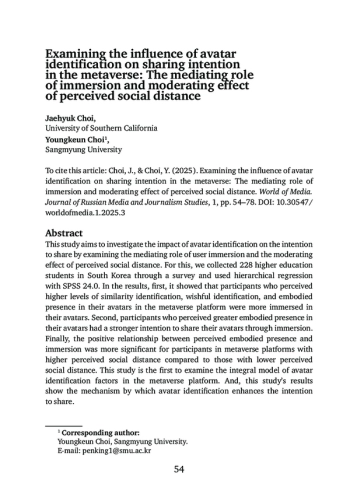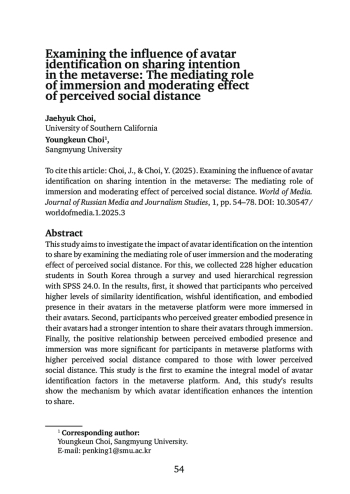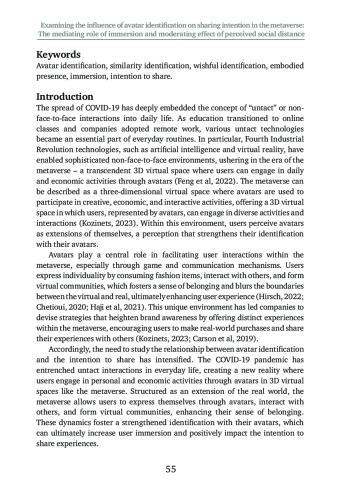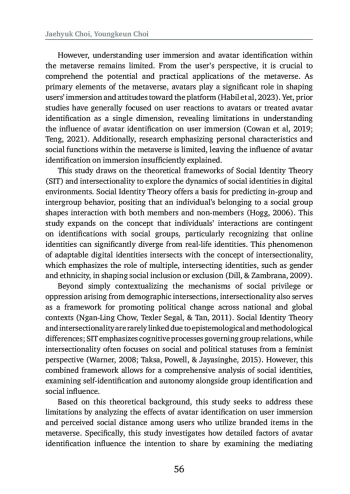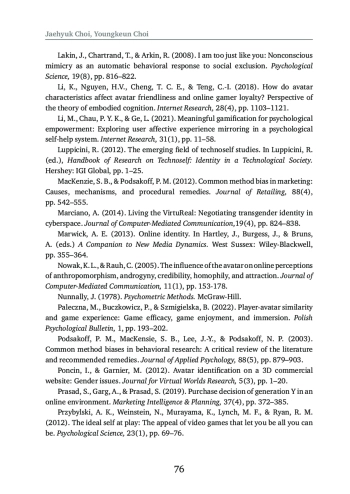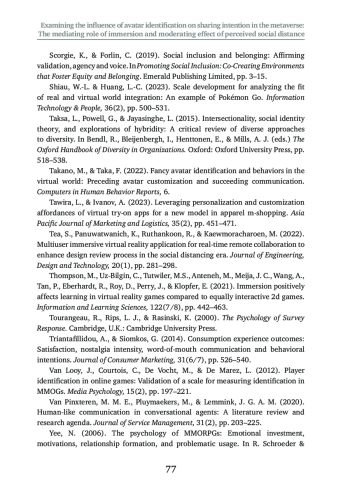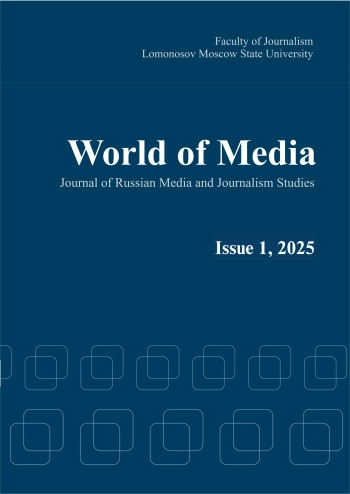This study aims to investigate the impact of avatar identification on the intention to share by examining the mediating role of user immersion and the moderating effect of perceived social distance. For this, we collected 228 higher education students in South Korea through a survey and used hierarchical regression with SPSS 24.0. In the results, first, it showed that participants who perceived higher levels of similarity identification, wishful identification, and embodied presence in their avatars in the metaverse platform were more immersed in their avatars. Second, participants who perceived greater embodied presence in their avatars had a stronger intention to share their avatars through immersion. Finally, the positive relationship between perceived embodied presence and immersion was more significant for participants in metaverse platforms with higher perceived social distance compared to those with lower perceived social distance. This study is the first to examine the integral model of avatar identification factors in the metaverse platform. And, this study’s results show the mechanism by which avatar identification enhances the intention to share.
Идентификаторы и классификаторы
The spread of COVID-19 has deeply embedded the concept of “untact” or nonfaceto-face interactions into daily life. As education transitioned to online classes and companies adopted remote work, various untact technologies became an essential part of everyday routines. In particular, Fourth Industrial Revolution technologies, such as artificial intelligence and virtual reality, have enabled sophisticated non-face-to-face environments, ushering in the era of the metaverse – a transcendent 3D virtual space where users can engage in daily and economic activities through avatars (Feng et al, 2022). The metaverse can be described as a three-dimensional virtual space where avatars are used to participate in creative, economic, and interactive activities, offering a 3D virtual space in which users, represented by avatars, can engage in diverse activities and interactions (Kozinets, 2023). Within this environment, users perceive avatars as extensions of themselves, a perception that strengthens their identification with their avatars.
Список литературы
1. AltspaceVR. (2020). New avatars! URL: https://altvr.com/new-avatars-coming- soon.
2. Bao, Z., & Yang, J. (2022). Why online consumers have the urge to buy impulsively: Roles of serendipity, trust and flow experience. Management Decision, 60(12), pp. 3350-3365.
3. Batat, W., & Hammedi, W. (2023). The extended reality technology (ERT) framework for designing customer and service experiences in phygital settings: A service research agenda. Journal of Service Management, 34(1), pp. 10-33. EDN: FMRXCH
4. Baumeister, R., & Leary, M. (1995). The need to belong: Desire for interpersonal attachments as a fundamental human motivation. Psychological Bulletin, 117(3), pp. 497-529.
5. Buhalis, D., Lin, M. S., & Leung, D. (2023). Metaverse as a driver for customer experience and value co-creation: Implications for hospitality and tourism management and marketing. International Journal of Contemporary Hospitality Management, 35(2), pp. 701-716. EDN: MLANEL
6. Carlson, J., Gudergan, S. P., Gelhard, C., & Rahman, M. M. (2019). Customer engagement with brands in social media platforms: Configurations, equifinality and sharing. European Journal of Marketing, 53(9), pp. 1733-1758.
7. Chetioui, Y., Benlafqih, H., & Lebdaoui, H. (2020). How fashion influencers contribute to consumers’ purchase intention. Journal of Fashion Marketing and Management, 24(3), pp. 361-380. EDN: MPZWSV
8. Cohen, J. (2001). Defining identification: A theoretical look at the identification of audiences with media characters. Mass Communication & Society, 4(3), pp. 245- 264.
9. Cowan, K., & Ketron, S. (2019). Prioritizing marketing research in virtual reality: Development of an immersion/fantasy typology. European Journal of Marketing, 53(8), pp. 1585-1611.
10. Davis, K. (2008). Intersectionality as buzzword: A sociology of science perspective on what makes a feminist theory successful. Feminist Theory, 9(1), pp. 67-85.
11. De Bruyn, A., & Lilien, G. L. (2008). A multi-stage model of word-of-mouth influence through viral marketing. International Journal of Research in Marketing, 25(3), pp. 151-163.
12. Dehghani, M., Lee, S. H. M., & Mashatan, A. (2020). Touching holograms with windows mixed reality: Renovating the consumer retailing services. Technology in Society, 63.
13. Dionisio, J. D. N., III, W. G. B., & Gilbert, R. (2013). 3D virtual worlds and the metaverse: Current status and future possibilities. ACM Computing Surveys (CSUR), 45(3), pp. 1-38.
14. Dill, B. T., and Zambrana, R. E. (2009). Critical thinking about inequality: An emerging lens. In Dill, B. T. & Zambrana, R. E. (eds.) Emerging Intersections: Race, Class, and Gender in Theory, Policy and Practice. New Brunswick: Rutgers University Press, pp. 1-21.
15. Endacott, J. & Brooks, S. (2013). An updated theoretical and practical model for promoting historical empathy. Social Studies Research and Practice, 8(1), pp. 41-58.
16. Feng, X., Wang, X.,& Su, Y. (2022). An analysis of the current status of metaverse research based on bibliometrics. Library Hi Tech, Vol. DOI: 10.1108/LHT-10-2022-0467
17. Flavián, C., Ibáñez-Sánchez, S., & Orús, C. (2019). Integrating virtual reality devices into the body: Effects of technological embodiment on customer engagement and behavioral intentions toward the destination. Journal of Travel & Tourism Marketing, 36(7), pp. 847-863.
18. Foster, J. K., McLelland, M. A., & Wallace, L. K. (2022). Brand avatars: Impact of social interaction on consumer-brand relationships. Journal of Research in Interactive Marketing, 16(2), pp. 237-258.
19. Fuschillo, G., Cayla, J., & Cova, B. (2022). Brand magnification: When brands help people reconstruct their lives. European Journal of Marketing, 56(3), pp. 768- 798. EDN: KIOBWW
20. Gabrielli, V., Baghi, I., & Codeluppi, V. (2013). Consumption practices of fast fashion products: A consumer-based approach. Journal of Fashion Marketing and Management, 17(2), pp. 206-224.
21. Goffman, E. (1986). Frame Analysis: An Essay on the Organization of Experience. Boston: Northeastern University Press.
22. Green, R., Delfabbro, P. H., & King, D. L. (2021). Avatar identification and problematic gaming: The role of self-concept clarity. Addictive Behaviors, 113.
23. Habil, S. G. M., El-Deeb, S., & El-Bassiouny, N. (2023). The metaverse era: Leveraging augmented reality in the creation of novel customer experience. Management & Sustainability: An Arab Review. DOI: 10.1108/MSAR-10-2022-0051
24. Haji, I. H. A., Peluso, A. M., & Jong, A. D. (2021). Online private self-disclosure’s potential for experiential value co-creation. European Journal of Marketing, 55(12), pp. 3059-3098. EDN: YSGFVB
25. Hirsch, P. B. (2022). Adventures in the metaverse. Journal of Business Strategy, 43(5), pp. 332-336. EDN: GLNNOL
26. Hogg, M. A. (2006). Social identity theory. In Burke, P. J. (ed.), Contemporary Social Psychological Theories. Stanford: Stanford University Press, pp. 111-136.
27. Holvino, E. (2012). The ‘simultaneity’ of identities: Models and skills for the twenty-first century. In Wijeyesinghe, C. L. & Jackson, B. W. (eds.) New Perspectives on Racial Identity Development: Integrating Emerging Frameworks. New York: New York University Press, pp. 161-191.
28. Jin, S. V., Muqaddam, A., & Ryu, E. (2019). Instafamous and social media influencer marketing. Marketing Intelligence & Planning, 37(5), pp. 567-579.
29. Jin, W., Sun, Y., Wang, N., & Zhang, X. (2017). Why users purchase virtual products in MMORPG? An integrative perspective of social presence and user engagement. Internet Research, 27(2), pp. 408-427.
30. Klimmt, C., & Hartmann, T. (2006). Effectance, self-efficacy, and the motivation to play video games. In P. Vorderer, & J. Bryant (Eds.), Playing Video Games: Motives, Responses, and Consequences. Abingdon: Routledge Taylor & Francis Group, pp. 153-168.
31. Kozinets, R. V. (2023). Immersive netnography: A novel method for service experience research in virtual reality, augmented reality and metaverse contexts. Journal of Service Management, 34(1), pp. 100-125. EDN: JBRQKQ
32. Lakin, J., Chartrand, T., & Arkin, R. (2008). I am too just like you: Nonconscious mimicry as an automatic behavioral response to social exclusion. Psychological Science, 19(8), pp. 816-822.
33. Li, K., Nguyen, H.V., Cheng, T. C. E., & Teng, C.-I. (2018). How do avatar characteristics affect avatar friendliness and online gamer loyalty? Perspective of the theory of embodied cognition. Internet Research, 28(4), pp. 1103-1121.
34. Li, M., Chau, P. Y. K., & Ge, L. (2021). Meaningful gamification for psychological empowerment: Exploring user affective experience mirroring in a psychological self-help system. Internet Research, 31(1), pp. 11-58.
35. Luppicini, R. (2012). The emerging field of technoself studies. In Luppicini, R. (ed.), Handbook of Research on Technoself: Identity in a Technological Society. Hershey: IGI Global, pp. 1-25.
36. MacKenzie, S. B., & Podsakoff, P. M. (2012). Common method bias in marketing: Causes, mechanisms, and procedural remedies. Journal of Retailing, 88(4), pp. 542-555.
37. Marciano, A. (2014). Living the VirtuReal: Negotiating transgender identity in cyberspace. Journal of Computer-Mediated Communication,19(4), pp. 824-838.
38. Marwick, A. E. (2013). Online identity. In Hartley, J., Burgess, J., & Bruns, A. (eds.) A Companion to New Media Dynamics. West Sussex: Wiley-Blackwell, pp. 355-364.
39. Nowak, K. L., & Rauh, C. (2005). The influence of the avatar on online perceptions of anthropomorphism, androgyny, credibility, homophily, and attraction. Journal of Computer-Mediated Communication, 11(1), pp. 153-178.
40. Nunnally, J. (1978). Psychometric Methods. McGraw-Hill.
41. Paleczna, M., Buczkowicz, P., & Szmigielska, B. (2022). Player-avatar similarity and game experience: Game efficacy, game enjoyment, and immersion. Polish Psychological Bulletin, 1, pp. 193-202.
42. Podsakoff, P. M., MacKensie, S. B., Lee, J.-Y., & Podsakoff, N. P. (2003). Common method biases in behavioral research: A critical review of the literature and recommended remedies. Journal of Applied Psychology, 88(5), pp. 879-903.
43. Poncin, I., & Garnier, M. (2012). Avatar identification on a 3D commercial website: Gender issues. Journal for Virtual Worlds Research, 5(3), pp. 1-20.
44. Prasad, S., Garg, A., & Prasad, S. (2019). Purchase decision of generation Y in an online environment. Marketing Intelligence & Planning, 37(4), pp. 372-385.
45. Przybylski, A. K., Weinstein, N., Murayama, K., Lynch, M. F., & Ryan, R. M. (2012). The ideal self at play: The appeal of video games that let you be all you can be. Psychological Science, 23(1), pp. 69-76.
46. Scorgie, K., & Forlin, C. (2019). Social inclusion and belonging: Affirming validation, agency and voice. In Promoting Social Inclusion: Co-Creating Environments that Foster Equity and Belonging. Emerald Publishing Limited, pp. 3-15.
47. Shiau, W.-L. & Huang, L.-C. (2023). Scale development for analyzing the fit of real and virtual world integration: An example of Pokémon Go. Information Technology & People, 36(2), pp. 500-531. EDN: DGREUN
48. Taksa, L., Powell, G., & Jayasinghe, L. (2015). Intersectionality, social identity theory, and explorations of hybridity: A critical review of diverse approaches to diversity. In Bendl, R., Bleijenbergh, I., Henttonen, E., & Mills, A. J. (eds.) The Oxford Handbook of Diversity in Organizations. Oxford: Oxford University Press, pp. 518-538.
49. Takano, M., & Taka, F. (2022). Fancy avatar identification and behaviors in the virtual world: Preceding avatar customization and succeeding communication. Computers in Human Behavior Reports, 6.
50. Tawira, L., & Ivanov, A. (2023). Leveraging personalization and customization affordances of virtual try-on apps for a new model in apparel m-shopping. Asia Pacific Journal of Marketing and Logistics, 35(2), pp. 451-471. EDN: VWPZIW
51. Tea, S., Panuwatwanich, K., Ruthankoon, R., & Kaewmoracharoen, M. (2022). Multiuser immersive virtual reality application for real-time remote collaboration to enhance design review process in the social distancing era. Journal of Engineering, Design and Technology, 20(1), pp. 281-298. EDN: VMZQMV
52. Thompson, M., Uz-Bilgin, C., Tutwiler, M.S., Anteneh, M., Meija, J. C., Wang, A., Tan, P., Eberhardt, R., Roy, D., Perry, J., & Klopfer, E. (2021). Immersion positively affects learning in virtual reality games compared to equally interactive 2d games. Information and Learning Sciences, 122(7/8), pp. 442-463.
53. Tourangeau, R., Rips, L. J., & Rasinski, K. (2000). The Psychology of Survey Response. Cambridge, U.K.: Cambridge University Press.
54. Triantafillidou, A., & Siomkos, G. (2014). Consumption experience outcomes: Satisfaction, nostalgia intensity, word-of-mouth communication and behavioral intentions. Journal of Consumer Marketing, 31(6/7), pp. 526-540.
55. Van Looy, J., Courtois, C., De Vocht, M., & De Marez, L. (2012). Player identification in online games: Validation of a scale for measuring identification in MMOGs. Media Psychology, 15(2), pp. 197-221.
56. Van Pinxteren, M. M. E., Pluymaekers, M., & Lemmink, J. G. A. M. (2020). Human-like communication in conversational agents: A literature review and research agenda. Journal of Service Management, 31(2), pp. 203-225. EDN: FICJDR
57. Yee, N. (2006). The psychology of MMORPGs: Emotional investment, motivations, relationship formation, and problematic usage. In R. Schroeder &.
58. Axelsson (Eds.), Avatars at Work and Play: Collaboration and Interaction in Shared Virtual Environments. London: Springer-Verlag, pp.187-207.
59. Yim, M. Y. C., Chu, S. C., & Sauer, P. L. (2017). Is augmented reality technology an effective tool for e-commerce? An interactivity and vividness perspective. Journal of Interactive Marketing, 39(1), pp. 89-103.
60. Zhang, M., Li, Y., Gu, R., & Luo, C. (2021). What type of purchase do you prefer to share on social networking sites: Experiential or material? Journal of Retailing and Consumer Services, 58.
Выпуск
Другие статьи выпуска
The article aims to outline bloggings as a complex social phenomenon and identify the current role of blogs in virtual reality. The literature review revealed that the evolving paradigm of civilizational growth has led to a hybrid environment, which combines the aspects of physical world and virtual reality artefacts, resulting in a unique media landscape, significantly impacting sociocultural and communicative dynamics. However, the field lacks studies on typical features of blogosphere, such as its inherent openness, fostering informal communication, intention to both monetization and self-expression. To address the study’s objectives the research adopts an integrative interdisciplinary approach, including socio-philosophical and semiotic cultural studies, theory of computer communication, network and Internet discourse studies to use data from various fields of humanitarian knowledge. It is concluded that originally created as online diaries, currently blogs as a diverse media platform demonstrate several unique features, including high personalization, audience feedback capabilities, constant user engagement with various types of information (verbal, audial, visual). These characteristics positioned blogs as key contributors to the growth of virtual sociality, leading to the emergence of a new type of society characterized by heightened human sensory experiences and the development of new empathetic models and behavioral attitudes. A notable sign of these changes is that the audience’s attention has shifted from professional media institutions to individual bloggers, who are increasingly adopting media-like behaviors. The current research adopts an interdisciplinary approach, merging socio-philosophical and semiotic cultural studies, as well as with theory of computer communication, network and Internet discourse studies. It also employs methods of Internet linguistics and the principles of pragmalinguistics; the axiological method helps to identify value-based sociocultural guidelines within the framework of globalization.
In order to promote cultural variety, encourage local involvement, and provide a voice to underrepresented groups, community radio stations (CRS) have become essential venues. Using information from 339 publications in the English language indexed in the Scopus database between 2000 and 2024, this bibliometric analysis attempts to map the research landscape on CRS methodically over the previous 20 years. This timeframe was chosen to capture significant developments in community radio stations, including policy shifts, technological advancements, and the rise of CRS movements in regions like South Asia, Africa, and Latin America. The analysis pinpoints important patterns in the field’s publication output, research hotspots, significant writers, and foundational publications. The data shows a consistent rise in scholarly interest, especially concerning the contribution of CRS to media democratization, community empowerment, and social transformation. A thematic analysis reveals recurrent research themes, such as CRS’s role as an alternative medium, how it affects local development, and the difficulties it faces in maintaining operations. Citation analysis reveals patterns of scholarly collaboration by highlighting the most significant publications and the growth of research networks. This study highlights how CRS has influenced the media environment and how they might support community-based projects. This work advances theoretical knowledge of CRS’s development and continued significance by thoroughly analyzing the scholarly discourse on the subject.
“Femvertising”, advertising that adopts the perspective of females, has become a popular global marketing strategy. Some Chinese brands are adopting it in their marketing communication. However, studies on audience response to femvertising mainly focus on Western consumers. Relevant research studies, particularly those with young consumers, are still scarce in China. This qualitative study aims to fill the research gap and examine young consumers’ responses to femvertising and its perceived effectiveness. Focus group interviews were conducted in March 2023 with three groups comprising female university students, male university students, and working females aged 20 to 25. The results showed that participants paid much attention to the advertising execution style and storytelling skills of femvertising. Liking of a specific feminist advertisement would enhance the brand image. However, a brand’s historical portrayal of female influences the communication effectiveness of its femvertising. An abrupt adoption of femvertising creates doubts and reservations. Female and male participants had different attitudes toward femvertising. As expected, female participants showed more appreciation of femvertising than male participants.
Статистика статьи
Статистика просмотров за 2025 год.
Издательство
- Издательство
- МГУ
- Регион
- Россия, Москва
- Почтовый адрес
- оссийская Федерация, 119991, Москва, Ленинские горы, д. 1
- Юр. адрес
- оссийская Федерация, 119991, Москва, Ленинские горы, д. 1
- ФИО
- Садовничий Виктор Антонович (РЕКТОР)
- E-mail адрес
- info@rector.msu.ru
- Контактный телефон
- +7 (495) 9391000
- Сайт
- https://msu.ru/
